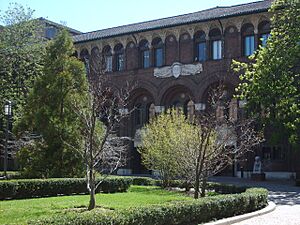Penn Museum facts for kids
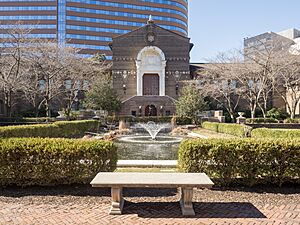
The Warden Garden and Main Entrance to the Penn Museum
|
|
| Established | 1887 |
|---|---|
| Location | 3260 South Street, Philadelphia, Pennsylvania United States |
| Type | Anthropology and archaeology |
| Public transit access | |
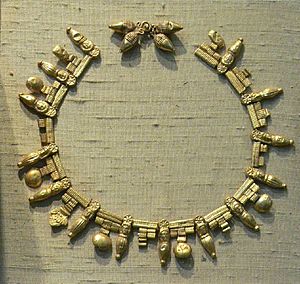
The Penn Museum is a fascinating place in Philadelphia, Pennsylvania. It's part of the University of Pennsylvania and is all about archaeology and anthropology. Think of it as a giant treasure chest filled with amazing objects from all over the world!
The museum is located in the University City area. It holds over 1.3 million artifacts. These include some of the best collections of art and items from the Middle East and Near East.
Contents
Discovering the Past: The Museum's Story
The Penn Museum started in 1887. It was first called the "University of Pennsylvania Museum of Archaeology and Anthropology." It began after a successful trip to an ancient city called Nippur in what is now Iraq. The university's leader, William Pepper, wanted a safe building to keep the treasures found there.
In the past, museums often worked with other countries to share discoveries. The Penn Museum did this too. This means most of its objects have a known history, which helps scientists learn more. Since it began, the museum's experts have gone on over 300 expeditions worldwide. They have explored many cultures and ancient sites.
Today, the museum has three floors of galleries. You can see items from ancient places like the Mediterranean, Egypt, the Near East, and Mesoamerica. There are also artifacts from the native peoples of Africa and North America. The museum also publishes a magazine called Expedition since 1958. This magazine shares new discoveries and research.
The Museum Building: A Grand Design
The museum building itself is a work of art! It has an Arts and Crafts style. It's one of the most famous buildings on the University of Pennsylvania campus. What you see today is only about one-third of the original grand plan. If it had been fully built, it would have been one of the biggest museums in the United States.
The building has a dramatic round room called a rotunda. It also features several courtyards, gardens, a fountain, and stone statues. Many talented architects from Philadelphia designed it. The first part was finished in 1899. The rotunda, which includes the Harrison Auditorium, was completed in 1915. Later, more sections were added, like the Coxe Memorial Wing for the Egyptian collection in 1926. The Sharpe Wing was added in 1929. The Academic Wing, with labs and classrooms, opened in 1971. The newest major addition was the Mainwaring Wing in 2002, which helps store the collections.
The Museum Library: A World of Knowledge
The Museum Library started in 1900. It began with the personal book collection of a professor named Daniel Garrison Brinton. His library had over 4,000 books, mostly about the native peoples of America and their languages. It also had old manuscripts about Central American languages, some of which are now very rare.
The library's collection grew with help from museum experts and donations. In 1942, Cynthia Griffin became the first full-time librarian. She made the library open to students, not just staff. She also helped the library connect with others around the world. Under her care, the collection more than doubled in 20 years!
Today, the library has about 115,000 books. It focuses on anthropology and archaeology, especially Mesoamerican archaeology. It also has many scholarly journals. The library offers computers, printing, and scanning. It has quiet rooms for studying and a collection of audio and video materials.
Amazing Collections from Around the World

The Penn Museum has huge collections. They are divided into three main types:
- Archaeology: Objects found from digging up ancient sites.
- Ethnology: Objects and ideas collected from people living today.
- Physical Anthropology: The physical remains of humans and other primates.
The museum has eleven permanent galleries. These include Africa, Asia, Egypt, Sphinx, Middle East, Eastern Mediterranean, Etruscan, Greece, Rome, Native American Voices, and Mexico and Central America. Many items are not always on display but are used for research or special exhibits.
Exploring Cultures: Ethnology and Archaeology Collections
Africa: A Rich Heritage
The Penn Museum has one of the largest collections of African objects in the country. Most of these items were collected between 1891 and 1937. They come from all over Africa, with many from the Democratic Republic of the Congo, Gabon, and Angola.
One special part is the Sherbro Island collection from Sierra Leone. In 1936–1937, an expert named Henry Usher Hall studied the Sherbro people. He collected textiles, sculptures, tools, and household items. His notes help us understand the Sherbro way of life.
The Central African collection has about 3,000 items. Many were collected by Leo Viktor Frobenius in 1906. These show the different art styles of groups like the Kuba and Kongo. There's also a Moroccan collection with clothing, rugs, weapons, and jewelry from 1898.
In 2019, the museum opened a new African gallery. It features a special dress called "Wearable Literature." This dress was designed by Breanna Moore and Emerson Ruffin.
North America: Ancient Stories and Traditions
The North American collections include items from 20,000 years ago to a few hundred years ago. Some were found in the late 1800s and early 1900s.
In 1896, Frank Hamilton Cushing found wolf, deer, and human masks in the waters off Key Marco, Florida. These items were very well preserved because they were underwater. Later, Edgar B. Howard found some of the oldest items in the collection. His digs in New Mexico helped identify the Clovis point. This showed that humans lived alongside animals like mammoths long ago.
The museum has about 40,000 items from around 200 Indigenous nations in North America. Many items from the Northwest Coast were collected by Louis Shotridge. He was a Tlingit man who worked for the museum in the early 1900s. Another professor, Frank Speck, also gave many items from the Sub-Arctic region. He even recorded songs from the Creek and Yuchi peoples.
Mexico and Central America: Mayan Wonders
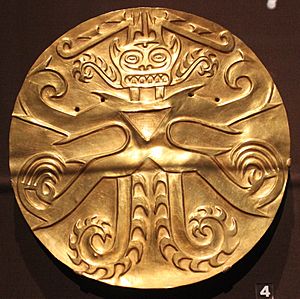
The museum's Mesoamerican collections include objects from Mexico, Guatemala, Belize, and other Central American countries. There are many masks, pottery, and textiles from Guatemala.
A special part is the Lilly de Jongh Osborne collection of Guatemalan textiles. It has complete outfits for men, women, and children from different villages. It also shows the tools used for weaving.
The Penn Museum also dug up the ancient Mayan city of Tikal in Guatemala from 1956 to 1970. Many important artifacts from this dig are on display. You can also see large stone carvings called stelae from other Mayan cities. The gallery also shows items from the Aztec and Teotihuacan cultures.
In 2019, a new "Mexico and Central America Gallery" opened. It features art from eight countries. One important object is Stela 14, a ten-foot-tall limestone rock with carvings. Tatiana Proskouriakoff found this object. She figured out how to read the Mayan hieroglyphics on it, which changed how we understand Mayan history!
South America: Diverse Cultures
The South American collections are as varied as the places they come from. These include the dry coast of Peru, the Andes Mountains, and the Amazon rainforest. The collections have items from Argentina, Bolivia, Brazil, Peru, and more.
The museum has strong collections from Bolivia, Brazil, Guyana, and Peru. Items from the Aymara, Quechua, and Yuracaré of Bolivia were collected by early explorers. More than thirty different Indigenous tribes from Brazil are represented.
Asia: Treasures from the East
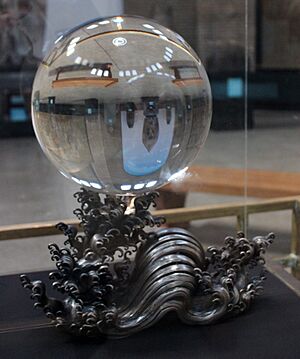
The Penn Museum's Asian collection has nearly 3,000 art objects and artifacts. They come from China, Tibet, Japan, South Korea, India, and other Asian countries. Many of these items focus on China.
A large part of the Chinese collection was bought or donated. It includes over 290 porcelain vases and sculptures collected by J. P. Morgan. Another important collection came from William and Isabel Ingram Mayer. They traveled across Mongolia and northern China in 1930-1931. Their collection has 464 small bronze items from ancient nomadic peoples. Maxwell Sommerville, an early museum curator, gave many items from Japan and India, including Kalighat paintings.
The Asian Gallery is in the large Harrison Rotunda. It has showcased the Chinese collection since 1915. A central piece is a ceramic statue of a Luohan, which is very old. Other rare Chinese artworks are two of the six horse panels from Emperor Taizong's tomb. These horses were famous for helping unify China. The only two panels outside of China were donated to the Penn Museum.
Another famous item is a perfectly round crystal ball. It is said to have belonged to Empress Cixi. This crystal ball and an Egyptian statue were stolen in 1988. They were found and returned in 1991 after a museum volunteer spotted the statue in an antique shop.
Egypt: Land of Pharaohs

The museum's collection of Egyptian artifacts is one of the best in the world. The Egyptian galleries have many statues, mummies, and carvings.
One of the most impressive items is a huge 13-ton granite Sphinx of Ramesses II. It dates back to about 1200 B.C. This sphinx and large columns came from the palace of Pharaoh Merenptah. They were found by a museum expedition to Egypt in 1915.
Iraq: Royal Tombs of Ur
The museum's most important collection might be from the Royal Tombs of Ur. The University of Pennsylvania worked with the British Museum to dig up this ancient city in Iraq. Ur was a rich city in ancient Sumer. The items from its royal tombs show how wealthy it was.
The collection includes crowns, figures, and musical instruments, many decorated with gold and jewels. A famous item is the Bull-headed lyre. The museum also has almost 30,000 clay tablets with ancient writings in Sumerian and Akkadian cuneiform. This is one of the largest collections in the world. It has many Sumerian school tablets and old stories.
Human History: Physical Anthropology Collections
Morton Collection: A Look at Human Skulls
The Penn Museum has about 1,300 human skulls collected by a 19th-century doctor named Samuel George Morton. The museum got this collection in 1966. Morton's work has been criticized because he used science to support racist ideas and collected human remains without permission.
The museum recognizes the problems with how the collection was made. In 2018, students found that 55 skulls in the collection belonged to enslaved people. In 2020, the museum announced it would move the collection into storage. They also planned to return or rebury the skulls of enslaved individuals. In 2024, the museum buried the remains of 19 African-American people from Philadelphia. This happened at Eden Cemetery, a place used by the African-American community.
See also
- Graduate Group in the Art and Archaeology of the Mediterranean World
- The Benghazi Venus
- List of museums with major collections of Egyptian antiquities
- Hiram M. Hiller, Jr.
- G. Roger Edwards


